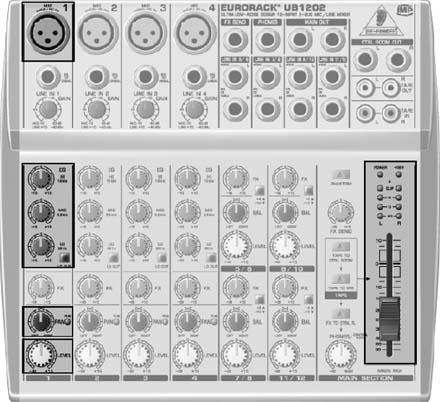Mix Your Podcast in Hardware
Mixers can look intimidating at first, but they are actually easy to use and very powerful.
Mixers are an inexpensive way to get your audio close to broadcast quality, with no digital editing. Figure 3-7 shows the Behringer UB1202 mixer.
Going from left to right on the setup you can see a number of horizontal strips. These are called channels. This mixer has an amazing 12 channels in it. The first four are mono channels capable of taking XLR [Hack #12] inputs. The XLR input of the first channel is highlighted in the upper lefthand corner.
Moving down the channel you can see a set of three knobs. This is a simple three-band equalizer [Hack #57] that can boost or reduce the low, middle, and high frequencies on the channel. This is great for getting rid of high-pitched noises, adding some presence to a person’s voice, or removing low hums.

Figure 3-7. The Behringer UB1202 mixer
Below the equalizer section, the next highlighted knob is the pan control. The pan positions the signal in the stereo space from left to right. By default, it’s in the middle—dead center between the two channels. If you are recording two microphones and you want the output to be stereo mixed, you will want one to go slightly to the left and the other to go slightly to the right. This gives listeners a sense that they are at the table with the two people who are talking.
Right below ...
Get Podcasting Hacks now with the O’Reilly learning platform.
O’Reilly members experience books, live events, courses curated by job role, and more from O’Reilly and nearly 200 top publishers.

